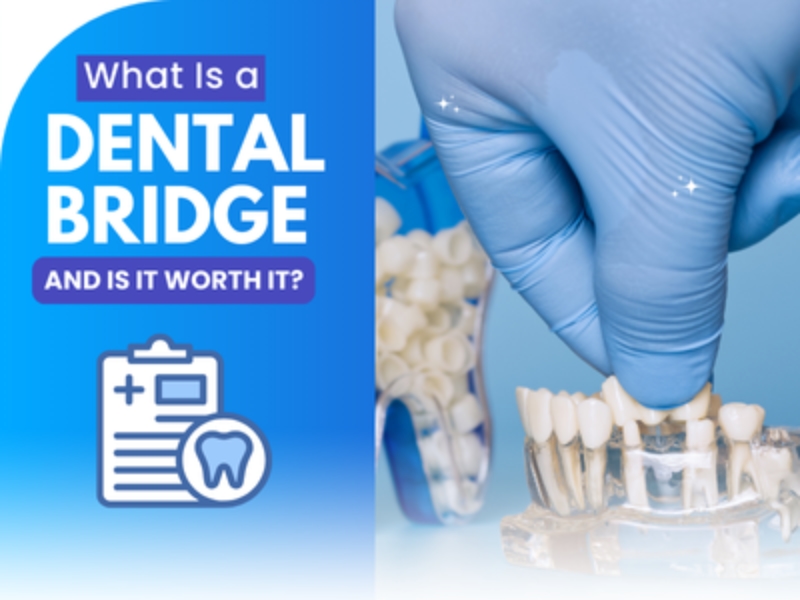A dental bridge is an excellent option for anyone wanting to replace a missing tooth! It not only looks great but also ensures that your teeth function just as they should. By filling in the space, you’ll keep your nearby teeth from shifting, making eating and speaking so much easier, and giving your smile a lovely boost! In this dental blog, we’ll chat about how to take care of your dental bridge so you can enjoy its perks for many years ahead!
What is a Dental Bridge?
A dental bridge is made up of artificial teeth, known as pontics, which are securely anchored to your neighboring natural teeth, called abutments. Dental bridges are typically held in place by crowns placed on the abutment teeth, or they can be bonded directly to those teeth for secure support. You'll find dental bridges crafted from a variety of materials, including sturdy gold alloys, non-precious alloys, and porcelain – often a beautiful porcelain can be fused to metal to achieve that natural look we all love!
How Should I Care for My Dental Bridge?
Taking care of your dental bridge is just as important as looking after your natural teeth! Brushing with fluoride toothpaste and flossing regularly are key to maintaining excellent oral health and extending the life of your bridge. Whether you prefer a manual or electric toothbrush, ensuring you clean around and under your bridge daily is essential for its upkeep.
Flossing with a bridge is a little different from traditional flossing, and using specialized tools can make all the difference. A floss threader or super floss can help you reach those hard-to-clean areas effectively. Many people also find using an oral irrigator super helpful for flushing out any bacteria or food particles hiding around their bridge. Don’t forget about interdental flossers, as they’re excellent for keeping your gums and teeth in tip-top shape!
Alongside your daily care, don’t forget the importance of visiting your dentist regularly – ideally every six months. Routine check-ups provide professional cleanings that remove any plaque or debris and your dentist will check for wear and tear on your bridge, ensuring that everything remains in excellent condition. Staying on top of these visits can help catch any potential issues early, sparing you from more costly dental problems down the line.
What Foods to Avoid?
Eating well is vital, especially when you have a dental bridge! You want to enjoy your meals comfortably while also protecting your bridge from damage. Aim to avoid hard, overly crunchy, or sticky foods, which could loosen the bridge or damage the abutment teeth. Foods like caramel, hard candy, and nuts are best enjoyed in moderation.
While porcelain is quite stain-resistant, it’s a wise idea to rinse your mouth after sipping beverages that might stain, like coffee or wine. This little habit helps keep your adjacent teeth bright and healthy, while also protecting your bridge from discoloration.
What is the Lifespan of a Bridge?
With the right care, a dental bridge can typically last around ten years! The longevity of your bridge depends on several factors, such as the materials used (with stronger materials like metal generally standing the test of time better than porcelain), and your personal oral hygiene routine, professional cleanings and diet play crucial roles as well.
Additionally, if you tend to grind or clench your teeth, this can shorten your bridge's lifespan, so it’s important to consult with your dentist about preventative options like custom nightguards to help protect your beautiful smile.
Common Issues with Bridges…
Like any dental restoration, dental bridges can face a few challenges over time. The most common issues usually involve structural or functional changes. You may notice some changes as your bridge ages, whether it’s related to its appearance or how it feels. If you detect any shifts in how your bridge looks or functions, it’s a great idea to make an appointment to see your dentist and discuss whether a replacement is needed or if any adjustments can be made.
Another common concern is food getting stuck under the bridge, which can be uncomfortable and lead to tissue irritation. If you’re finding it tricky to clean around and beneath your bridge at first, don’t hesitate to ask your dental professional for tips and techniques using tools tailored for dental prosthetics. Consistent cleaning will help prevent tooth decay under the bridge, saving you from potentially needing replacements or complicated procedures down the line. In some cases, individuals consider dental implants as an alternative for replacement.
To sum it up, a dental bridge is a wonderful option for anyone dealing with a missing tooth, delivering both aesthetic appeal and essential functional support. By prioritizing care for your bridge and being mindful of any potential issues, you’ll not only enhance its longevity but also boost your overall oral health. With a bit of attention and some joyful visits to your dentist, you can maintain that beautiful smile and enjoy all the great things in life that come with it!
